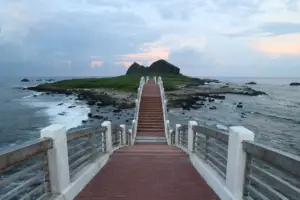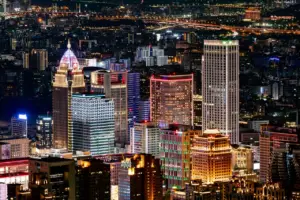Are you ready for an adventure? Look no further than Taiwan, where you can experience a perfect 19-day itinerary filled with culture, nature, and delicious food. From modern cities to traditional villages, hot springs to national parks, there’s something for everyone in this diverse and beautiful country.
Your journey will begin in Taipei, the bustling capital city that seamlessly blends modernity and tradition. You’ll explore iconic landmarks like Taipei 101 and the National Palace Museum, as well as hidden gems like the historic Dihua Street and the vibrant night markets.
But Taipei is just the beginning – the rest of Taiwan awaits, with breathtaking landscapes, unique cultural experiences, and unforgettable memories waiting to be made. Get ready to discover the best of Taiwan in 19 days.
Key Takeaways
- Taiwan offers a diverse range of experiences including culture, nature, and food.
- Must-visit destinations in Taiwan include Taipei, traditional villages like Jiufen and Shifen, hot springs like Wulai and Beitou, and Taroko National Park for stunning scenery and hiking opportunities.
- Taiwanese cuisine is a mix of Chinese, Japanese, and indigenous influences, and visitors should try popular dishes like Beef Noodle Soup and Bubble Tea.
- Attending festivals like the Lantern Festival, Dragon Boat Festival, and Mid-Autumn Festival is a great way to experience Taiwanese culture and meet friendly locals.
Exploring Modern Taipei
Let’s dive into the bustling streets of modern Taipei and see what this vibrant city has to offer!
Start your day by visiting the iconic Taipei 101 skyscraper, which was once the tallest building in the world. Take a ride up to the observation deck on the 89th floor for breathtaking views of the city skyline and surrounding mountains.
Next, head to the vibrant district of Ximending, known as the ‘Harajuku of Taipei.’ This pedestrian-friendly area is filled with trendy shops, street art, and delicious street food. Don’t miss out on trying the famous Taiwanese street snack, stinky tofu.
After a day of exploring the modern city, it’s time to venture out and discover traditional Taiwanese villages.
Discovering Traditional Taiwanese Villages
Explore the charm of Taiwan’s traditional villages and immerse yourself in their unique cultures. As you venture out of the bustling city of Taipei, you’ll find yourself transported to a world of quaint, picturesque towns that have managed to preserve their traditional way of life.
Here are three must-visit villages that you should add to your itinerary:
-
Jiufen: This historic mining town is famous for its narrow alleyways, red lanterns, and teahouses. Take a stroll through the streets and soak in the stunning views of the Pacific Ocean. Don’t forget to try their famous street food, such as taro balls and fish balls, and visit the A-Mei Tea House, which inspired the Miyazaki film, Spirited Away.
-
Shifen: This charming village is known for its sky lanterns, which are released into the air during festivals and celebrations. Take a train ride on the Pingxi Railway Line, which runs through Shifen, and make a wish as you release a lantern into the sky. You can also visit the Shifen Waterfall, one of the most beautiful waterfalls in Taiwan.
-
Lukang: This ancient town is filled with temples, shrines, and traditional architecture. Take a leisurely stroll through the streets and admire the intricate details of the old houses. Don’t miss the opportunity to try the local delicacies, such as the Lukang mochi, a glutinous rice cake filled with peanuts and sesame seeds.
After immersing yourself in the culture and history of these traditional villages, it’s time to relax and unwind. Soak in natural hot springs and rejuvenate your body and mind.
Soaking in Natural Hot Springs
You can’t miss out on soaking in the natural hot springs in Taiwan’s traditional villages. These hot springs are not only a great way to relax and rejuvenate, but they also offer stunning views of the surrounding mountains and forests. Taiwan is home to many hot springs, and some of the best ones are located in traditional villages such as Wulai, Jiaoxi, and Beitou.
To make it easier for you to plan your hot springs adventure, here’s a table that lists the top hot springs in Taiwan, along with their location and unique features:
| Hot Spring | Location | Unique Features |
|---|---|---|
| Wulai Hot Springs | New Taipei City | Known for its sulfuric water and outdoor hot spring experience |
| Jiaoxi Hot Springs | Yilan County | Contains minerals that are good for the skin |
| Beitou Hot Springs | Taipei City | Historic hot spring area with Japanese-style bathhouses |
After a relaxing soak in the hot springs, it’s time to lace up your hiking boots and explore the stunning Taroko National Park.
Hiking in Taroko National Park
To fully appreciate the beauty of Taiwan’s natural landscapes, immerse yourself in the breathtaking scenery of Taroko National Park by embarking on a hiking adventure. The park boasts towering cliffs, turquoise rivers, and lush forests that will leave you in awe.
As you trek along the trails, you’ll witness the grandeur of the Taroko Gorge, a 19-kilometer canyon carved by the Liwu River. You’ll also encounter suspension bridges, waterfalls, and tunnels ingeniously designed to blend with the environment.
Hiking in Taroko National Park is not only a feast for the eyes but also a great way to get some exercise. The trails vary in difficulty, so whether you’re a beginner or an experienced hiker, you’ll find a route that suits your level.
Don’t forget to bring water and snacks, and wear comfortable shoes and clothes appropriate for the weather. After a day of hiking, you’ll surely work up an appetite, and what better way to reward yourself than by sampling delicious Taiwanese cuisine?
Sampling Delicious Taiwanese Cuisine
Indulge in mouth-watering Taiwanese cuisine that’ll tantalize your taste buds and leave you wanting more.
Taiwan is known for its diverse and delicious food scene, which is a mix of Chinese, Japanese, and indigenous influences. Here are some must-try dishes that’ll give you a taste of the local cuisine:
-
Beef Noodle Soup: This hearty soup is made with tender beef, chewy noodles, and a savory broth that’s packed with flavor. It’s the ultimate comfort food and a staple dish in Taiwan.
-
Bubble Tea: You can’t leave Taiwan without trying this iconic drink. It’s a refreshing blend of tea, milk, and chewy tapioca balls that are irresistible. You can find bubble tea shops all over the country, and there are endless flavor combinations to choose from.
As you savor the delicious Taiwanese cuisine, you’ll also get to enjoy the beautiful coastal views in Hualien.
Enjoying Coastal Views in Hualien
Take in the stunning coastal views of Hualien while enjoying a leisurely stroll or bike ride along the picturesque coastline. The city is located on the east coast of Taiwan and is known for its breathtaking natural landscapes. You can rent a bike or go on a walking tour to explore the area.
The coastline is dotted with unique rock formations and stunning beaches that are perfect for a picnic or some beachcombing. Be sure to stop by the Qixingtan Beach, a popular spot among locals and tourists alike.
After taking in the coastal views, head to Hualien’s historic sites and museums to learn more about the city’s rich culture and heritage. The Hualien County Cultural and Creative Industries Park is a great place to start. This park was once a sugar factory and has since been transformed into a creative hub with various exhibitions and shops.
Another must-visit is the Chihsing Tan Katsuo Museum, where you can learn about the traditional method of drying and processing katsuo, or bonito fish. Hualien is full of hidden gems that are waiting to be discovered, so don’t miss out on exploring this charming city.
Visiting Historical Sites and Museums
You won’t want to miss out on exploring Hualien’s historical sites and museums. They offer a chance to immerse yourself in the city’s rich culture and heritage. Here are some must-visit places that will surely evoke strong emotions:
-
The Hualien Cultural Creative Industries Park, where you can learn about the city’s history and culture through interactive exhibits and workshops.
-
The Hualien County Stone Sculpture Museum, showcasing the works of local artists and their unique stone-carving techniques.
-
The Pine Garden, a former residence turned museum that offers a glimpse into the life of a prominent local family during the Japanese colonial period.
-
The Liyu Lake National Scenic Area, a natural wonder surrounded by lush forests and dotted with pagodas and pavilions.
-
The Chihsing Tan Scenic Area, where you can witness the stunning contrast between the blue ocean and the golden sand.
After immersing yourself in the history and culture of Hualien, get ready to experience the vibrancy of Taiwanese festivals and events.
Experiencing Taiwanese Festivals and Events
Immersing oneself in Taiwanese festivals and events offers a unique opportunity to witness the vibrant culture and traditions of Hualien. Whether it’s the Lantern Festival in February, the Dragon Boat Festival in June, or the Mid-Autumn Festival in September, there is always something exciting happening in Taiwan.
To help you plan your trip, here is a table of some of the most popular festivals and events in Taiwan:
| Festival/Event | Date | Location | Description |
|---|---|---|---|
| Lantern Festival | February | All over Taiwan | Celebrated on the 15th day of the first lunar month, this festival features colorful lanterns, parades, and fireworks. |
| Dragon Boat Festival | June | All over Taiwan | This festival honors the memory of Qu Yuan, a famous Chinese poet. Dragon boat races are held in many places, and sticky rice dumplings (zongzi) are a popular treat. |
| Mid-Autumn Festival | September/October | All over Taiwan | Also known as the Moon Festival, this holiday is celebrated on the 15th day of the 8th lunar month. People gather to eat mooncakes and admire the full moon. |
Attending a festival or event is a great way to experience Taiwanese culture and meet friendly locals. Be sure to check the dates of these festivals and events before your trip, and don’t miss out on the chance to join in the fun!
Frequently Asked Questions
What are the visa requirements for traveling to Taiwan?
If you’re planning to travel to Taiwan, you may be wondering about the visa requirements.
The good news is that for many countries, including the United States, Canada, and most of Europe, a visa isn’t required for stays of up to 90 days.
However, you will need a valid passport with at least six months of validity remaining, and you may be asked to show proof of onward travel (such as a return ticket) and evidence of sufficient funds to cover your stay.
If you’re unsure about your specific situation, it’s best to check with the nearest Taiwanese embassy or consulate before your trip.
What is the best time of year to visit Taiwan?
The best time to visit Taiwan would be during the fall months of September to November. During this time, the weather is pleasant, with cooler temperatures and less rainfall. It’s also the season of the Mid-Autumn Festival, which is celebrated with mooncakes, lanterns, and traditional performances.
The spring months of March to May are also good to visit Taiwan, as the cherry blossoms bloom in various locations across the country. However, be prepared for occasional rainfall during this time.
The summer months of June to August can be hot and humid, with occasional typhoons, while the winter months of December to February can be chilly, especially in the higher elevations of the country.
Overall, the fall months are the best time to visit Taiwan for comfortable weather and cultural festivities.
How much does it cost to travel around Taiwan for 19 days?
Traveling around Taiwan for 19 days can cost anywhere from $1,500 to $3,000 depending on your travel style and preferences. This includes accommodation, transportation, food, and activities.
If you’re on a budget, you can find cheap hostels or Airbnb accommodations, take public transportation, and eat at local eateries. However, if you prefer more luxurious accommodations and activities, your expenses will increase.
Overall, Taiwan is an affordable destination with plenty of options for all budgets. It’s important to research and plan ahead to ensure you have a comfortable and enjoyable trip within your budget.
What are some useful phrases in Mandarin Chinese for travelers in Taiwan?
If you’re planning to travel to Taiwan, it’s always helpful to have a few Mandarin Chinese phrases under your belt.
Firstly, greetings such as "nÇ hÇŽo"(hello) and "xiè xiè"(thank you) will come in handy when interacting with locals.
Additionally, knowing how to ask for directions with "zhèlÇ zÄ›nme zÇ’u"(how do I get here?) and ordering food with "wÇ’ xiÇŽng dÇŽ cà i"(I would like to order) can make your trip more enjoyable.
Lastly, being able to bargain with "tà i guì le"(too expensive) and "kÄ› yÇ pián yì yÄ« diÇŽn ma?"(can you give me a discount?) can be useful when shopping at markets.
With these basic phrases, you’ll be able to communicate effectively and have a more immersive experience in Taiwan.
What are some tips for staying safe and healthy while traveling in Taiwan?
Staying safe and healthy while traveling in Taiwan is essential for an enjoyable trip. To avoid getting sick, make sure to drink only bottled water and avoid consuming raw or undercooked food.
It’s also important to protect yourself from the sun by wearing sunscreen and a hat, especially during the summer months. Taipei and other major cities in Taiwan are generally safe, but it’s still important to be aware of your surroundings and keep your valuables close to you.
Petty theft can occur in crowded areas, so keep an eye on your belongings. Additionally, if you plan on renting a scooter or driving in Taiwan, make sure to wear a helmet and follow traffic laws.
By taking these precautions, you can have a safe and enjoyable trip in Taiwan.
Conclusion
Congratulations! You’ve completed an amazing 19-day adventure in Taiwan, experiencing the best of what this beautiful country has to offer.
You’ve explored the bustling city of Taipei, discovered traditional villages, soaked in natural hot springs, hiked in Taroko National Park, sampled delicious cuisine, enjoyed coastal views, visited historical sites and museums, and experienced festivals and events.
As you reflect on your journey, you realize that Taiwan truly is a hidden gem in Asia, with a rich culture, history, and natural beauty.
From the majestic mountains to the stunning coastlines, Taiwan has it all. And with friendly locals, delicious food, and affordable prices, it’s a perfect destination for any traveler.
Thank you for joining us on this journey, and we hope you’ll come back to Taiwan to discover even more of its wonders. Until next time, safe travels!
















































































